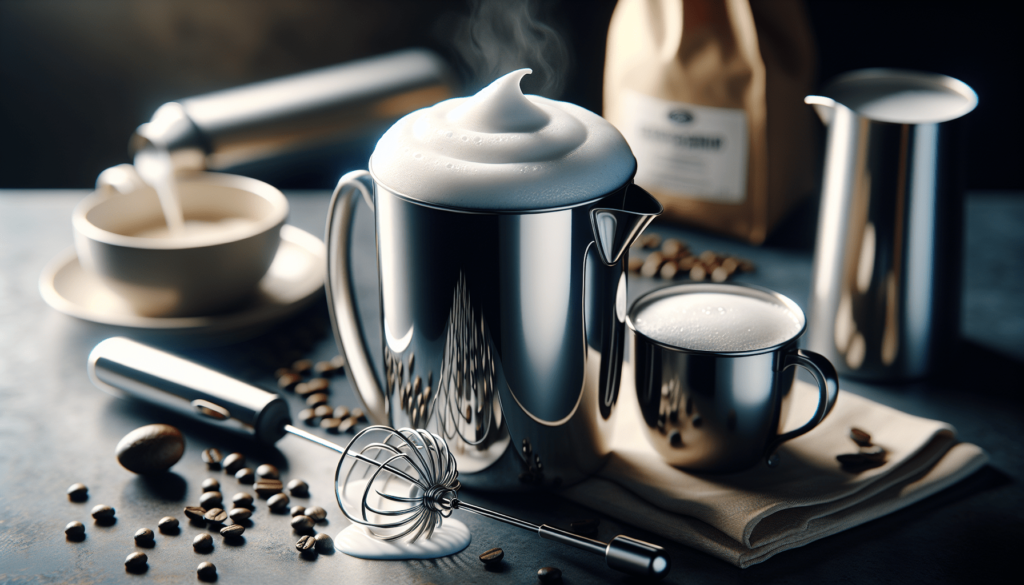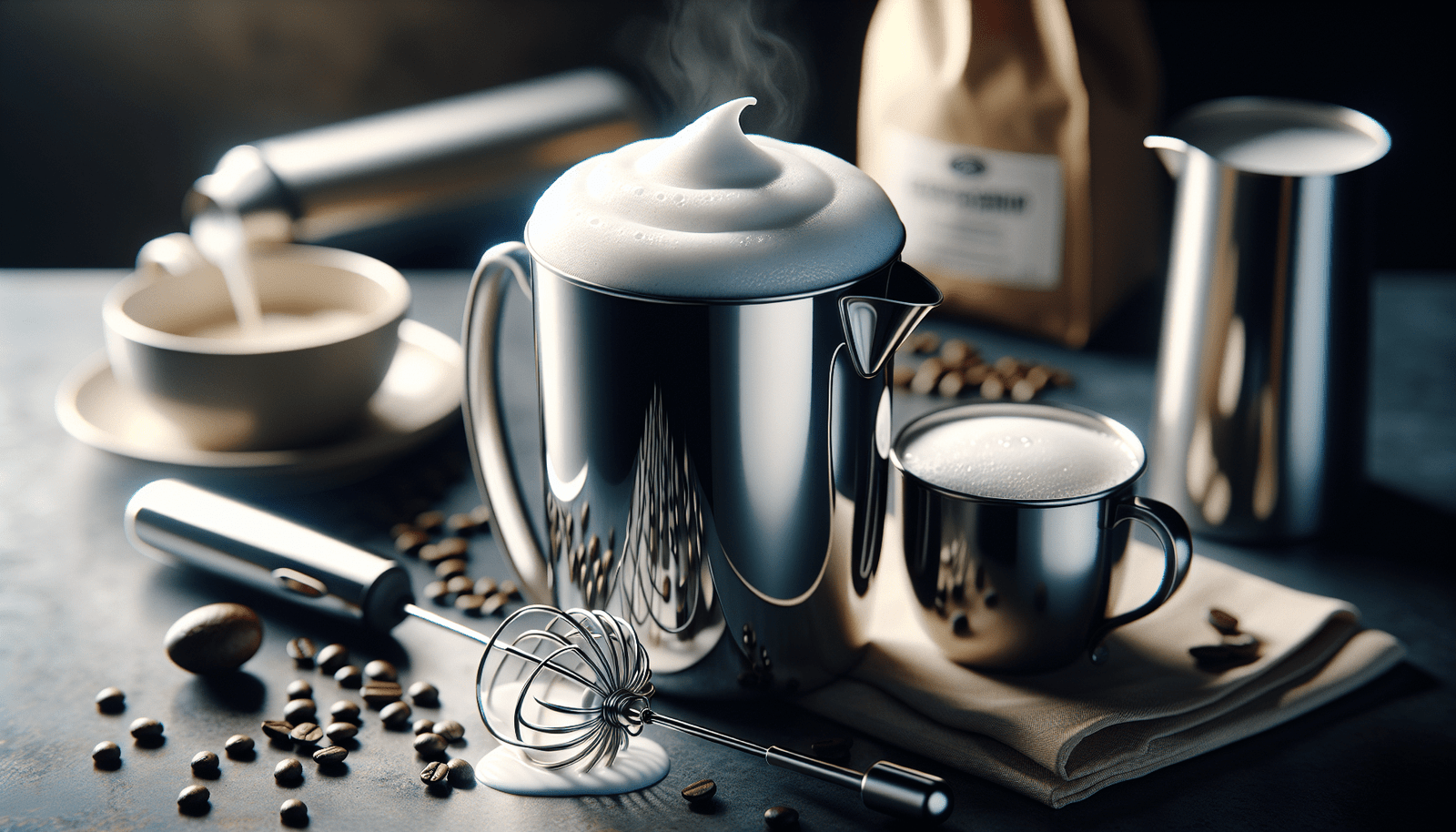Are you looking to step up your coffee game with a delicious cappuccino at home? Frothing milk is a key step in achieving that creamy, velvety texture that makes a cappuccino so special. In this article, we will walk you through the simple steps to frothing milk for a cappuccino, so you can enjoy a café-quality drink from the comfort of your own kitchen. Let’s get frothing!
How To Froth Milk For A Cappuccino
So, you’ve always wanted to make your own delicious cappuccinos at home, but you’re not quite sure how to froth milk properly. Well, you’ve come to the right place! In this friendly and detailed guide, we’ll walk you through the process step by step to help you achieve that perfect, creamy froth for your cappuccino.

Why is Frothing Milk Important for a Cappuccino?
Before we dive into the how-to, let’s talk about why frothing milk is so important when making a cappuccino. Frothing milk not only adds a beautiful aesthetic to your drink but also enhances the taste and texture. The frothy milk creates a creamier mouthfeel and adds a slight sweetness that complements the bold flavor of espresso. So, if you want to elevate your cappuccino experience, mastering the art of frothing milk is key!
Equipment Needed
Before you get started on frothing your milk, you’ll need to gather the necessary equipment. Here’s what you need:
- Milk frother: This can be a manual or electric frother, depending on your preference.
- Milk: Choose your milk of choice – whether it’s whole milk, skim milk, almond milk, or soy milk.
- Milk pitcher: A stainless steel pitcher works best for frothing milk.
- Thermometer: A thermometer will help you monitor the temperature of the milk.
- Espresso machine (optional): If you want to make an authentic cappuccino, you’ll need an espresso machine.
Just having the right equipment can make a big difference in the frothing process. Before we move on to the actual frothing, make sure you have everything you need at hand!
Types of Milk Frothers
There are a few different types of milk frothers available, each with its pros and cons. Here are the most common types:
Manual Frother
A manual frother is a hand-operated tool that requires you to pump a plunger up and down to create frothy milk. This type of frother is affordable, easy to use, and portable. However, it may take a bit of effort to froth the milk manually.
Electric Frother
An electric frother is a machine that froths the milk for you with the push of a button. This type of frother is convenient, efficient, and can produce consistent results. However, electric frothers tend to be more expensive compared to manual frothers.
Steam Wand (Espresso Machine)
If you have an espresso machine, chances are it comes with a steam wand for frothing milk. The steam wand produces powerful steam to heat and froth the milk simultaneously. While this method requires some practice to master, it can create professional-quality microfoam for your cappuccino.
Choose the type of milk frother that suits your preference and budget. Each type has its own advantages, so pick one that best fits your needs!
Steps to Froth Milk for a Cappuccino
Now that you have your equipment ready and you’ve chosen a milk frother, it’s time to start frothing! Follow these simple steps to froth milk like a barista:
Step 1: Fill the Milk Pitcher
Pour a desired amount of milk into the milk pitcher. Remember that milk expands when frothed, so make sure not to fill the pitcher more than halfway to allow room for the froth to form.
Step 2: Heat the Milk (optional)
If you prefer your cappuccino with hot milk, you can heat the milk before frothing. Use a microwave or stovetop to warm the milk to your desired temperature. Remember not to overheat the milk, as it can affect the texture of the foam.
Step 3: Froth the Milk
Now, it’s time to froth the milk! Depending on the type of milk frother you’re using, follow the manufacturer’s instructions. If you’re using a manual frother, pump the plunger up and down until the milk reaches your desired frothiness. For electric frothers, simply press the froth button and let the machine do the work for you. If you’re using a steam wand, position the wand into the milk and turn on the steam to froth the milk while swirling the pitcher.
Step 4: Monitor the Temperature
While frothing the milk, keep an eye on the temperature using a thermometer. The ideal temperature for frothing milk for a cappuccino is between 140°F to 160°F (60°C to 71°C). Once the milk reaches the desired temperature, remove it from the heat source immediately to prevent scalding.
Step 5: Swirl and Tap
After frothing the milk, give the pitcher a quick swirl to incorporate the foam with the milk. Tap the pitcher on a flat surface to break any large bubbles and create a smooth, creamy texture.
By following these steps, you’ll be able to froth milk like a pro and create the perfect foam for your cappuccino.

Tips for Frothing Milk
Frothing milk may seem simple, but there are a few tips and tricks that can help you achieve better results. Here are some useful tips for frothing milk for a cappuccino:
Use Cold Milk
For the best results, use cold milk straight from the refrigerator. Cold milk will froth better and create a denser foam compared to room temperature or warm milk.
Position the Steam Wand Correctly
If you’re using a steam wand to froth milk, make sure to position the wand just below the surface of the milk. Tilt the pitcher slightly to create a whirlpool effect, which helps incorporate the foam with the milk.
Don’t Froth Too Long
Over-frothing the milk can result in stiff, dry foam that doesn’t blend well with the milk. Froth the milk just until it reaches the desired texture, then stop to avoid ruining the foam.
Practice Makes Perfect
Frothing milk may take some practice to master, especially if you’re using a manual frother or steam wand. Don’t get discouraged if your first attempts don’t turn out perfectly – keep practicing, and you’ll soon become a pro at frothing milk!
Experiment with Milk Types
Different types of milk froth differently, so don’t be afraid to experiment with various milk options. Whether you prefer whole milk for a rich and creamy foam or almond milk for a dairy-free alternative, find the milk that suits your taste preferences.
Troubleshooting Common Issues
Even with the right equipment and technique, frothing milk can sometimes lead to unexpected issues. Here are some common problems you may encounter when frothing milk and how to troubleshoot them:
Large Bubbles
If your frothed milk has large bubbles instead of a smooth and creamy texture, it may be due to over-frothing. To fix this issue, tap the milk pitcher on a flat surface to break the bubbles and swirl the milk to incorporate the foam.
Thin Foam
Thin foam can result from using the wrong milk type or not frothing the milk long enough. To improve the foam density, switch to a different milk type or froth the milk for a few seconds longer to create a thicker foam.
Burnt Milk
If you overheat the milk while frothing, it can scald and produce a burnt flavor. To avoid this issue, monitor the milk’s temperature closely and remove it from the heat source as soon as it reaches the ideal frothing temperature.
No Froth
If you’re struggling to create froth when frothing the milk, it could be due to using the wrong type of milk or not frothing the milk correctly. Try switching to a different milk type with a higher fat content, such as whole milk, or adjust your frothing technique to create more foam.
By identifying and addressing these common issues, you can troubleshoot any problems that arise while frothing milk for your cappuccino.
Conclusion
Congratulations, you’ve made it to the end of our guide on how to froth milk for a cappuccino! By following the steps, tips, and troubleshooting advice outlined in this article, you’ll be well on your way to creating delicious, cafe-quality cappuccinos at home. Remember, practice makes perfect, so don’t be discouraged if your first attempts aren’t flawless. Keep experimenting and honing your frothing skills, and soon enough, you’ll be frothing milk like a professional barista. Enjoy your homemade cappuccinos, and savor every frothy sip! Cheers!

